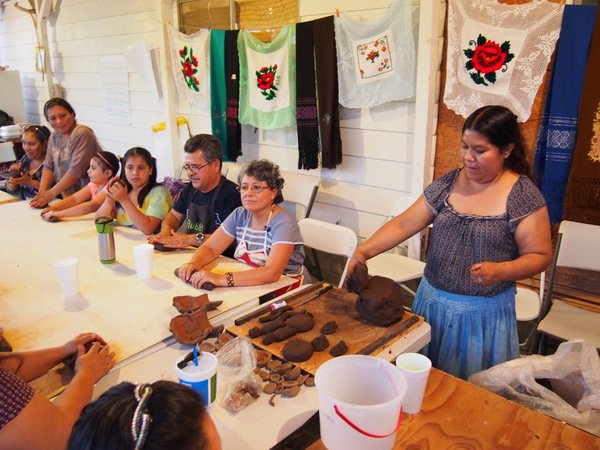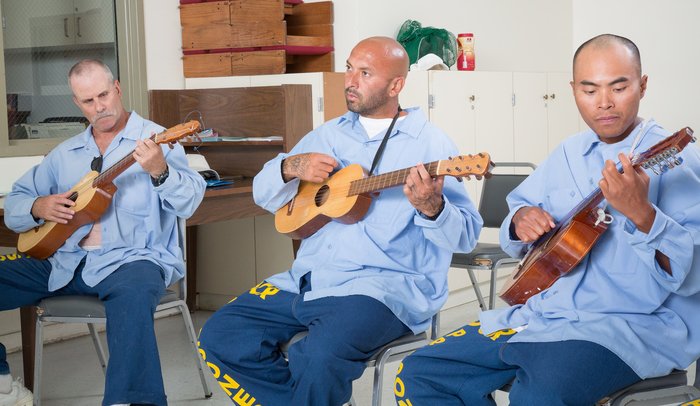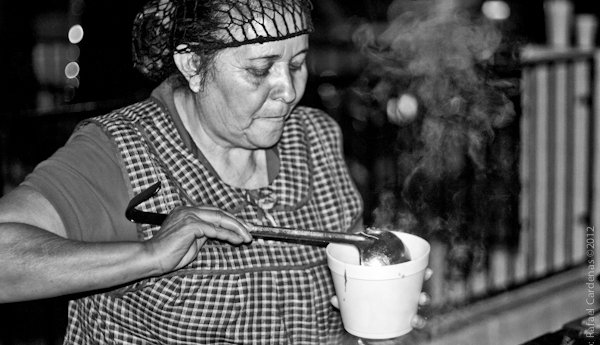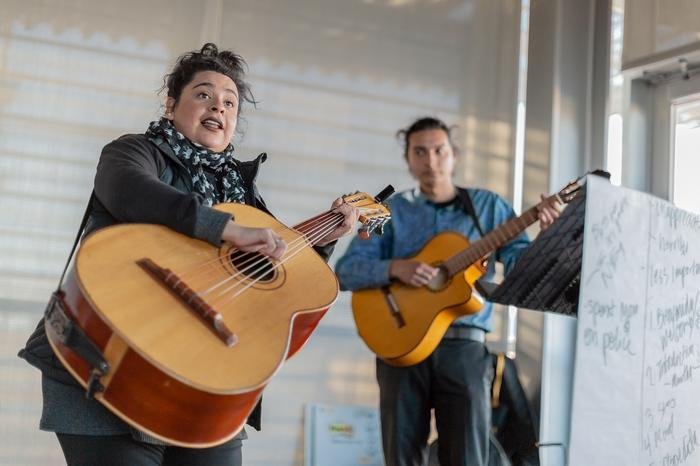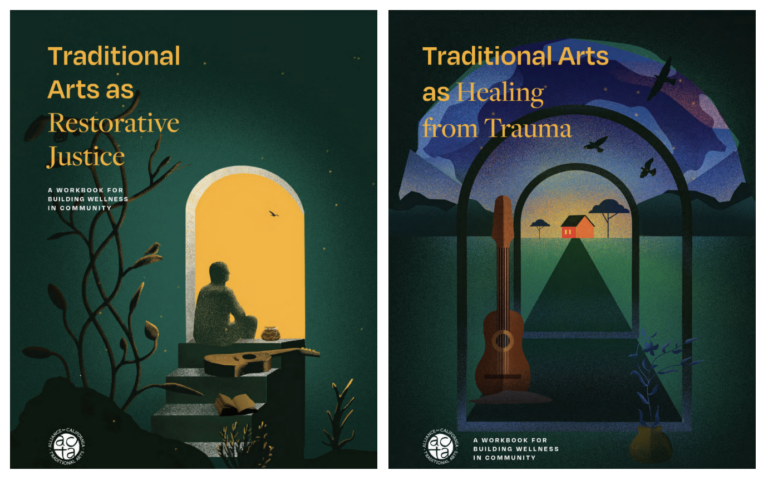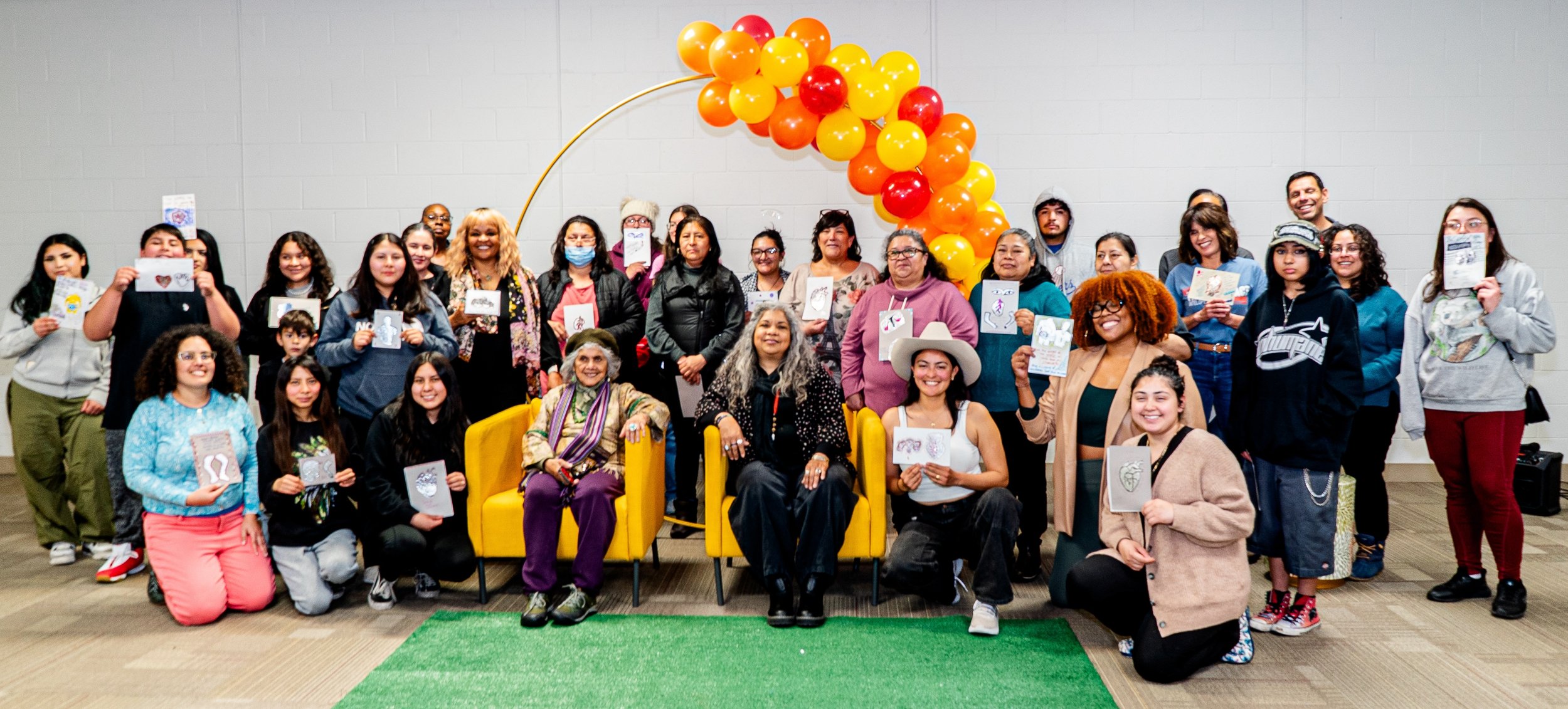Health Equity
ACTA has long been at the forefront of promoting arts for health equity, recognizing the inseparable link between living cultural heritage and public health. Our initiatives, from exploring the health benefits of traditional arts to convening discussions on the topic of arts in health, from weaving traditional arts into our Building Healthy Communities and Arts in Corrections work to developing methodologies like Participatory Cultural Asset Mapping, are all rooted in our deep belief in the healing power of traditional arts.
Crucially, we draw inspiration from the voices of California's diverse culture bearers. They've been the custodians of these traditions, passing them down through generations, and they eloquently articulate how the transmission and sharing of cultural practices are foundational to community wellbeing. This wisdom isn't new; it's been woven into the fabric of communities in California for generations.
About the images featured in this timeline.
“Embracing the healing power of traditional arts
We were at a moment of existential soul searching. We recognized that we were on the outskirts of the arts field and that arts funders had limited resources, and yet it was plain to see traditional arts’ impact on health and wellbeing, a sector with abundant funding and in need of new ideas. Hugo Morales of Radio Bilingüe and Holly Sidford of Helicon Collaborative were early thought partners, helping us envision the role that ACTA and traditional arts could play in improving health outcomes.”
“Hosting an Arts in Health roundtable at Grantmakers in the Arts
At the Grantmakers in the Arts national conference, we test the waters by hosting a roundtable breakfast on arts for health, called “Can Culture Save Our Communities?”. At the time, there was a debate amongst arts policymakers about the instrumental versus the intrinsic value of the arts. Dozens of our colleagues show up for a spirited discussion about the value of culture in California communities, and we leave feeling like we’re on to something transformative for the field and for ACTA.
”
“Publishing a pioneering study in the emerging arts and health field
We publish a seminal study on the potential to promote health through community-centered traditional arts. At the time, the idea of hiring health researchers to evaluate an arts program was radical. “Weaving Traditional Arts into the Fabric of Community Health” reveals the tangible health benefits experienced by participants of our Apprenticeship Program and Living Cultures Grants Program. Conducted in collaboration with health researchers from UC Davis, the groundbreaking study uncovered a wealth of positive outcomes, including enhanced well-being among seniors, young adults, and new immigrants.
“Launching our Building Healthy Communities program for arts and civic engagement
With funding from the California Endowment, we begin a long-term engagement to address health inequities through the traditional arts in four communities: Boyle Heights, Merced, Santa Ana, and the Eastern Coachella Valley. We collaborate with over 100 organizations in and alongside these communities to identify their cultural treasures: the people, places, groups, and events that hold cultural meaning. We envision how we can better lift up and expand those cultural treasures to effect specific policy change in schools, neighborhoods, preventative health, and anti-displacement.
Everywhere from quilting circles to trailer parks, embroidery classes to songwriting workshops, we gather community members around traditional artmaking and support avenues for information sharing and grassroots advocacy. In these hyper-local, intimate spaces, communities articulate their most urgent needs and opportunities for collective action, whether for restorative justice at school, dignified and affordable homes, or culturally relevant healthcare.Learn more about Building Healthy Communities →
”
“Establishing our Participatory Cultural Asset Mapping Methodology
Through the Building Healthy Communities initiative, we develop and codify our Participatory Cultural Asset Mapping Methodology, in which we convene a local task force to collect questionnaires identifying the cultural treasures of a given community. These asset mapping methods honor and make visible local cultural treasures and create spaces of belonging—an essential prerequisite for social change and racial equity. We continue to offer Participatory Cultural Asset Mapping services to this day.Learn about our consulting services →
”
“Making change through collective songwriting in Boyle Heights
When Quetzal Flores joins our Los Angeles office, his perspective as a practicing artist, culture bearer, and social justice advocate enables us to engage the community with a new tool: collective songwriting. A communal practice with strong roots in the Zapatista movement of Chiapas, and employed by Chicano activists, our collective songwriting workshops bring community members together to openly discuss local issues and channel their voices into music with meaning. Out of the songwriting process arises a collective vision for the Boyle Heights community, and an opportunity for collective action. ”
“Launching our Arts in Corrections programming
The California Arts Council asks arts service providers for programming in the state prison system. As the only traditional arts provider in the pilot year, we leap at the opportunity to bring the healing power of traditional arts to incarcerated people—a community in need of hope and restoration. Our first program launches at California State Prison in Corcoran. Dozens of teaching artists, including Cesar Castro, Quetzal Flores, Michael McCarty, and Omar Ramirez, have since connected thousands of incarcerated individuals with their cultural heritage through art forms like Mexican son jarocho and Afro-Colombian percussion. Many more organizations follow our lead.Learn more about Arts in Corrections →
”
“Celebrating the first SaludArte festival
We inaugurate the first SaludArte festival as a testament to the flourishing cultural treasures identified and nurtured through the Building Healthy Communities initiative. This all-day celebration in Boyle Heights brings together neighbors for workshops on traditions from kite-making and drumming to mural painting and Obon Japanese dance. The festival embodies our commitment to building community health from within, and fostering a vibrant and interconnected neighborhood.Learn more about the festival →
”
“Expanding our methodology to LA’s Promise Zone Arts
The Los Angeles Department of Cultural Affairs contracts us to bring our participatory cultural asset mapping methodology to a federally designated Promise Zone, including the neighborhoods of Pico Union, Koreatown, Hollywood and East Hollywood, Thai Town, Little Armenia, Little Bangladesh, Historic Filipinotown, and El Salvador Corridor. We conduct 35 site visits and 5 public gatherings alongside LA Commons, to identify more than 1,000 cultural assets in these communities. The Promise Zone Arts Live! event in 2018 is the culminating celebration of this community development project.
”
“Scaling up our Arts in Corrections work
Building on our successful 10-year track record, we expand our Arts in Corrections program to seven regions statewide after the California Arts Council and the California Department of Corrections double their investment in our work. At our peak, we employ 45 traditional teaching artists at 18 institutions across the state. Our workshops create a sense of cultural belonging among incarcerated individuals, and traverse cultural and social divides by encouraging interaction, creativity, healing, and understanding through a variety of cultural practices.”
“Artist mentorships key in Building Healthy Communities — Boyle Heights
Through our cultural mapping process, ACTA identifies culture bearers deeply integrated in Boyle Heights. Our mentorship model pairs emerging artists with seasoned cultural practitioners, who guide them in reframing their cultural practice as a form of advocacy and leadership. Omar Ramirez mentors Juana Mena to develop a quilting curriculum that emphasizes the role of traditional arts as a tool for restorative justice and community healing.”
“A seminal evaluation of the impact of our Arts in Corrections work
California Correctional Institution (CCI) calls on ACTA to create an arts program for incarcerated men released from long-term solitary confinement. We collaborate with the Asian American Center on Disparities Research at UC Davis to evaluate incarcerated participants who engaged in our storytelling, music, or visual art programming at CCI. The evaluation measures the effects of arts programming on these participants: we find that arts programming enriched their family and social relationships, cultivated personal growth, and enhanced mental health and psychological wellbeing. This study actively informs our ongoing work and helps us advocate for expanded funding.”
“Legalizing street vending in Los Angeles
It’s hard to imagine, but street food vending was once illegal in Los Angeles. In a major policy win, Los Angeles legalizes street vending in 2018. As part of our Activating Cultural Assets project, we conduct three ten-week workshops focused on integrating arts practices into three Boyle Heights community campaigns: Legalize Street Vending, Restorative Justice/School Climate, and the Affordable Care Act/The Remaining Uninsured. Through collective songwriting, ACTA convenes residents of Boyle Heights to activate a campaign to legalize street vending.
Our collective organizing was vital to the push to recognize street vendors as legitimate entrepreneurs and culture bearers. These essential micro-entrepreneurs create spaces for people to feel at home and connected to their community through beloved foodways traditions.Watch a video about the workshop →
”
“Launching our Reentry Through the Arts program
Knowing the liberatory effects that traditional artists have inside prisons, we launch Son de Libertad, an 18-week program for people returning to their communities after incarceration, in partnership with the Amity Foundation and The Wellness Center L.A. The program consists of two traditional arts workshops: Mexican son jarocho music, dance, and verse at the Amity Foundation; and Afro-Colombian percussion at Homeboy Industries. These workshops aim to guide formerly incarcerated individuals as they reintegrate into community and heal them of the trauma of the carceral system.”
“Documenting ACTA’s approach to building health equity with strategies for practitioners
After over a decade of experience, we publish a bilingual exploration of how traditional arts can help address social determinants of health like structural racism and poverty. Co-authored with Dr. George Lipsitz of UC Santa Barbara, “SaludArte: Building Health Equity on the Bedrock of Traditional Arts and Culture” not only documents our approach to health equity through traditional arts but also offers a toolkit, tactics, and case studies to empower other practitioners.”
“Launching La Cultura Cura workshops
Amid the COVID-19 pandemic and social distancing, we get a contract from the LA County Department of Mental Health to reduce the stigma around mental health services in Latino communities. We launch La Cultura Cura, a series of bilingual online workshops as a part of our Building Healthy Communities work in Boyle Heights, but reaching a broader population in other parts of Los Angeles. In partnership with a mental health community outreach worker, ACTA’s Artist Fellows create paths for community members and leaders to cope with stress and anxiety through the co-creation and engagement intrinsic to traditional arts.Read more about La Cultura Cura →
”
“Creating and sharing digital curricula for incarcerated students in lockdown
When California State Prisons pauses visitor access due to COVID, we adapt swiftly to continue Arts in Corrections programming for incarcerated students on long-term lockdown, and support our 35+ teaching artists, many of whom lost their other jobs. We extend benefits and employee protections to our teachers, enabling them to create innovative written curricula for remote learning and produce 27 new educational videos on traditional arts for anyone eager to learn as part of our Engaging Tradition series. The videos span mural making to creative writing, the history of Rumba to social justice theatre, airing for the first time inside California state prisons.”
“Encouraging public health with ACTAvando Contra COVID
During the vaccination drive, we are commissioned by the Governor’s office to enlist traditional artists to serve as trusted messengers for community wellbeing. In the San Joaquin Valley, where we see high rates of COVID-19 and low rates of vaccination, we create and distribute five new artworks in Spanish, English, and Mixtec by beloved Latinx artists and ensembles: Los Originarios del Plan, Grupo Recreación Musical, Poet Laureate Emeritus Juan Felipe Herrera, and NEA National Heritage Fellow Carmencristina Moreno. Through regional music, multilingual poetry, and radio drama, these artists urge individuals to get vaccinated to safeguard their communities and families from COVID-19.”
“Los Angeles establishes Youth Development Dept.
Under Building Healthy Communities, and as part of the Invest in Youth coalition, ACTA plays a pivotal role in advocating for a Youth Development Department in Los Angeles. Through collaborative efforts, including collective songwriting sessions led by mariachi musician Vaneza Calderón, ACTA empowers youth to identify and tell their stories. After seven years of dedicated work, youth activists score a victory as L.A. agrees to fund a $1.1-million city youth department.”
“Launching the CARE program for restorative justice
ACTA receives two grants from the California Department of Corrections and Rehabilitation: California Reentry and Enrichment (CARE) and the Innovative Programming Grant (IPG). Our two most recent programs — Traditional Arts as Healing from Trauma and Traditional Arts as Restorative Justice — integrate artists, art forms, and healing interventions, building upon the success of our existing rehabilitative in-prison programs and further highlighting the deep connections between the traditional arts and healing and restoration.Read our two accompanying CARE workbooks →
”
“Co-sponsoring a national conference on health equity through arts
Drawing from over a decade of experience and dozens of case studies and reports, we’re invited by the University of Florida Center for Arts in Medicine to host and present at the Creating Healthy Communities Convening with other collaborating organizations. This event brings together individuals working at the intersection of arts, public health, and community development, and fosters cross-sector collaboration to build healthier, stronger, and more equitable communities.”
“The Boyle Heights Community Plan integrates art and policy
As part of the Eastside LEADS (Leadership for Equitable & Accountable Development Strategies) coalition, we advocate for tenant protections and sustainable housing solutions in Los Angeles County. ACTA staff, artists, and Public Counsel lawyers lead the Eastside LEADS consulta (or ‘survey’) committee and work together to create a Boyle Heights Community Plan. To ensure the plan reflects the resources and needs of the community, we gather and incorporate input from community culture bearers and advocates for years, often through traditional arts practices. We submit recommendations for the Boyle Heights Community Plan Update to the City Clerk of Los Angeles in 2023, highlighting how cultural treasures in Boyle Heights play an important role in building arts and health equity into local public policy.”
“Cultural Asset Mapping in the Antelope Valley
In partnership with The California Endowment (TCE), ACTA expands health equity efforts into Los Angeles County’s underserved Antelope Valley. Through partnerships with local organizations like Cancel the Contract Antelope Valley and The Wow Flower Project, ACTA nurtures youth and parent leaders to craft fresh narratives on community health, and fostering collective action to reimagine community safety and build wellbeing. Using cultural asset mapping, we involve local residents, organizations, and culture keepers to identify and document cultural resources.”
“Reentry for Justice-Impacted Families in the Antelope Valley
ACTA launches its Reentry Through the Arts program in the Antelope Valley, designed for formerly incarcerated participants and their families in the Antelope Valley. Partnering with the Los Angeles County Department of Arts and Culture (LACDAC) and the Justice, Care, and Opportunities Department (JCOD), the Developing Opportunities and Offering Reentry Solutions (D.O.O.R.S) initiative allows ACTA to provide traditional arts workshops for individuals and families to find connection, healing, and resources to continue to rebuild their lives and reintegrate into their communities. ”
Timelines At-A-Glance



